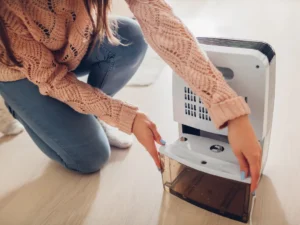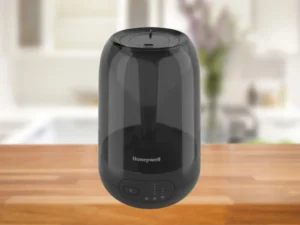Humidifiers are a real lifesaver during those dry months, like winter, keeping the indoor air nice and comfortable by adding much-needed moisture. But the thing is, if you don’t stay on top of maintaining them, those humidifiers can become a breeding ground for bacteria and mold – and that’s the last thing you want in your home. While humidifiers are fantastic for tackling dry air, you have to ensure you’re regularly cleaning them. It’s a bit of extra work, but keeping your home healthy and comfortable is worth it.
In this guide, we’ll talk about how to clean a humidifier properly and its importance, as well as provide step-by-step instructions to help you keep your device in top-notch condition.
The Benefits Of Humidifier Maintenance
 Before we delve into how to clean a humidifier properly, we must know its benefits. Firstly, a well-maintained humidifier is a lifesaver during the dry winter months. It effectively soothes discomforts such as dry nose, throat, lips, and skin, providing much-needed relief from winter’s harsh conditions. No more waking up with a scratchy throat or cracked lips—clean humidifier air ensures you feel refreshed and hydrated. Moreover, the moisture from a clean humidifier can tackle common issues caused by the HVAC system; issues like static electricity, wallpaper peeling, and paint cracking may arise.
Before we delve into how to clean a humidifier properly, we must know its benefits. Firstly, a well-maintained humidifier is a lifesaver during the dry winter months. It effectively soothes discomforts such as dry nose, throat, lips, and skin, providing much-needed relief from winter’s harsh conditions. No more waking up with a scratchy throat or cracked lips—clean humidifier air ensures you feel refreshed and hydrated. Moreover, the moisture from a clean humidifier can tackle common issues caused by the HVAC system; issues like static electricity, wallpaper peeling, and paint cracking may arise.
Neglecting the maintenance of your humidifier can create an environment suitable for microorganism growth. As the CDC highlights, bacteria, fungi, and amebas can form a sticky group called a biofilm, which helps their survival and growth. Some of these microorganisms can be harmful and may cause various health issues, including upper respiratory tract infections, allergy or asthma exacerbations, gastrointestinal problems if ingested, or skin or eye infections if exposed to the eyes or skin.
The Best Way To Clean A Humidifier
Step 1: Tools and Supplies Needed
Before we start the cleaning process, let’s make sure we have all the necessary tools and supplies. You’ll typically need white vinegar (which you can make yourself), water, a soft brush or cloth, and possibly some mild detergent. Additionally, suppose specific product cleaning recommendations are unavailable. In that case, the EPA suggests using a 3% hydrogen peroxide solution to clean any surfaces that come in contact with water.
When selecting cleaning products, opt for those recommended by the manufacturer or labeled as safe for use in humidifiers. Harsh chemicals can leave behind residues or damage the humidifier’s components, compromising its performance and potentially posing health risks. White vinegar, which you can make alone, is an excellent natural cleaner known for effectively removing mineral buildup and disinfecting surfaces without leaving harmful residues.
Step 2: Disassemble Your Humidifier
Disassembly and preparation are crucial steps in this guide on how to clean a humidifier properly. Start by unplugging the device and carefully taking it apart according to the manufacturer’s instructions. This process usually involves removing the water tank, filter, and other removable components. Take time with this step because removing every piece isn’t just about getting a better clean; it’s also about staying safe. So, follow those instructions carefully, and ensure you’ve removed all the parts that can come off before you start cleaning.
Step 3: Cleaning The Water Reservoir, Tank, Base, and Components
Here’s how to clean a humidifier properly: fill the tank with 2 cups of pure white vinegar and water, then allow it to soak for at least 30 minutes to loosen mineral deposits and kill bacteria. Seal it shut, give the container a good shake, or use the brush you prepared earlier to dislodge any sediment. Make sure you get into every nook and cranny. Consider it a mini workout for your arms!
If stubborn sediments are clinging, pour vinegar directly onto those spots and let it soak before repeating the shaking or brushing process. While the tank is soaking, clean the humidifier base and any other components with a mixture of water and vinegar or mild detergent. You must ensure all surfaces are thoroughly cleaned and rinsed to remove any traces of cleaning agents before putting them back together.
Step 4: Tips for Preventing Mold and Bacteria Growth
Proper drying techniques prevent mold and bacteria growth in your humidifier. After cleaning, allow all components to air dry completely before reassembling the unit. Avoid leaving moisture trapped in crevices or hidden areas, as this can create an ideal breeding ground for microorganisms. Patience is key here as you want to complete this step.
Another pro trick to keep your humidifier squeaky clean is to use distilled water or demineralization cartridges. These help prevent mineral buildup, which can lead to all sorts of funky stuff growing in your humidifier. Plus, it’ll keep it running smoother for longer.
How Often Should I Clean A Humidifier?

So, how often should you give your humidifier a good scrub? The American Academy of Allergy, Asthma, and Immunology experts suggest a regular cleaning routine with portable models needing a thorough cleaning every three days to keep mold growth in check and ensure good indoor air quality. You can disinfect the humidifier once or twice a month using a 3% hydrogen peroxide solution for an extra disinfection level.
Last but not least, there are special conditions where you need to clean your humidifier immediately. If you spot mold or mildew, notice any funky smells, or find that your humidifier isn’t working as well as it used to, it’s time to break out the cleaning supplies.
By responding to these indicators first-hand, you can prevent further contamination and ensure the longevity of your humidifier.
End Note:
Proper humidifier maintenance isn’t just about cleanliness—it’s about fostering a healthier and cozier environment for you and your family. Following these steps to clean a humidifier ensures optimal performance and safeguards against potential health risks associated with dirty humidifiers. Keep in mind that putting in a bit of effort to clean can make a big difference in maintaining fresh and healthy indoor air.
If you need some extra help with your humidifier or HVAC system, don’t hesitate to contact our team at Johnson’s Heating today. Our heating and cooling experts will happily provide expert advice and services to keep your home comfortable and healthy.


Recent Comments